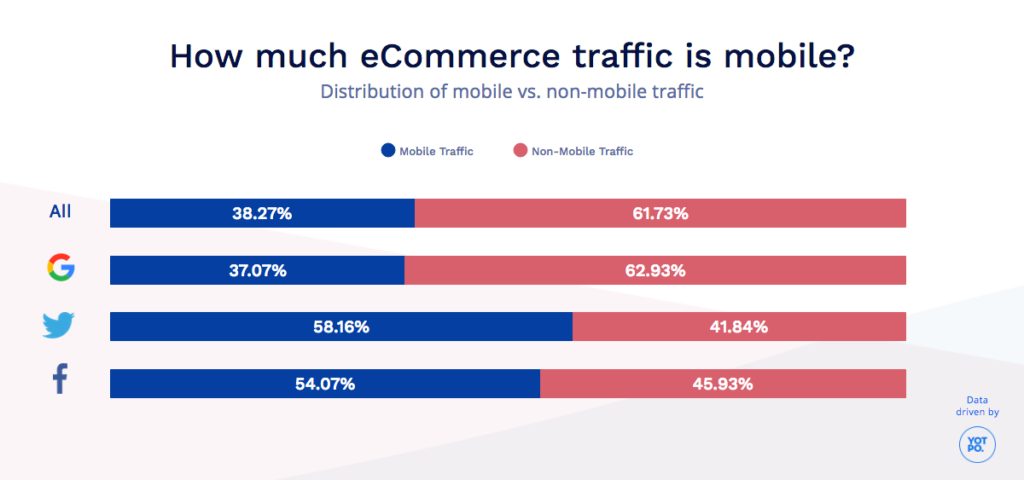We’ve all been there: you’ve got a few minutes before a meeting, so you pull out your phone or tablet to kill time. You check your emails – nothing new. No unread texts either.
You scroll through a news app absentmindedly, and then you wander over to Facebook or Twitter to see what’s going on in your social networks. You may not know it, but as you sift through baby photos and status updates, you’re also subconsciously window shopping.
As brick-and-mortar stores die out, social applications are becoming the new spot to wander through a virtual mall, checking out what new tech gadget all your friends have liked recently or the article on the top 5 must-have backpacks everyone’s sharing.
Even if consumers aren’t actively seeking eCommerce information on social media, the proliferation of paid ads and social referrals has made eCommerce content omnipresent.
And it’s much more likely to affect consumers when they’re accessing from mobile devices than when they’re on their desktops.
In fact, social mobile channels are the number one driver of eCommerce traffic.
A recent study by our Yotpo Analytics team of over 100,000 eCommerce stores found that the majority of social eCommerce traffic takes place on mobile.
On average, 54% of Facebook traffic comes from a mobile device and 58% of Twitter traffic comes from mobile.
In contrast, only 37% of total Google traffic came from mobile.
Similarly, a study from ShareThis shows that not only is most of the social traffic coming from mobile, but most of the social engagement as well. Their study found that half of all Facebook shares come from mobile devices, and that number jumps to an astonishing 75% on Pinterest and Twitter.
With mobile driving the biggest source of eCommerce social traffic, and the majority of social shares, it’s even more important to optimize your social profiles, pages, and posts to be mobile friendly.
Here are best practices for creating social pages that shine on mobile.
Remember it’s not just what you say, but how you say it
When users are scrolling through their news feeds, they’re making snap decisions on which content is valuable enough to attract their attention.
Make sure yours meets the cut.
Users only click on one in five headlines that they read – how do you ensure yours makes the 20%?
When it comes to social media, brevity is key. Headlines must be short, catchy, and interesting.
By no means are we suggesting you create clickbait content, but it is vital to make your copy concise and appealing.
It’s always important to follow headline best practices and proven formulas for all your content, but when it comes to social media, it’s even more necessary.
There are plenty of formulas and tips for how to write a perfect headline, but the truth is, you’ll never know what works until you try it! Unfortunately, social media requires quick turnaround time, which means A/B testing copy isn’t always feasible.
The good news is, switching up headlines across different social media platforms can give you insight into what your customers respond to.
Additionally, switching up the headline keeps you from looking like a carbon copier with the same exact headline copy on every social media platform.
Many users receive push notifications to their phone from their favorite social media platforms – don’t be that brand that simultaneously releases the exact same message across five different platforms.
Release updates at different times, with different headlines, to collect valuable analytics about what works best.
Tinder up your social profile
Take a cue from Tinder when optimizing your brand’s social pages.
On mobile devices, you have a few fractions of a moment to catch and sustain users’ attention.
This means you need to stand out so they don’t swipe away and on to something better that catches their eye.
What does this mean for you? You need a beyond-awesome header photo and concise, interesting bio.
Take advantage of header photos to show your brand’s personality. Additionally, ensure you don’t confuse visitors with incohesive visual branding across different social media channels.
Learn to read the social mind on the go
One of the most important aspects of optimizing social for mobile is understanding how the mobile mind works.
Mobile users are often accessing their devices for short spurts, rather than spending extended time engaging as they would on a desktop.
This means that you need to get consumers directly to where they want to go, without interruptions.
A slight distraction or slowdown can cause them to navigate to a competitor. Loading speed must be as fast as possible, but must also make their navigation path as simple and seamless as possible.
Do away with mobile pop-ups and required sign-ups and always take consumers to a mobile-friendly page.
If your whole site is responsive, making mobile-friendly pages shouldn’t be an issue, but if users are being redirected to a specific landing page, ensure it’s optimized for mobile. Make navigation simple and short.
When preparing for mobile users, remember that they are often not using social media on their mobile devices to make direct purchases.
Rather, focus on social as a way to increase brand experience and give them pertinent information when they need it.
Highlight prices and product details prominently so they don’t need to go searching for information.
Don’t forget: It’s all about location, location, location
This age-old adage still carries truth, even in the days of mobile and social.
Although now, location is less about looking for a perfect spot for a storefront than looking for the best way to target consumers by location.
One of the biggest benefits of using mobile and social in conjunction is the ability to combine real-time geo-location data with targeted specials via social media.
Even if you don’t have a physical store, you can still use location to your advantage.
For example, announce special area-wide sales in preparation for certain big days, like offering Mardi Gras discounts for New Orleaners or college specials on big game days.
Conclusion
These are some of the ways to boost your social traffic, reach, and engagement with mobile users, but don’t forget about the importance of general mobile optimization.














 Join a free demo, personalized to fit your needs
Join a free demo, personalized to fit your needs